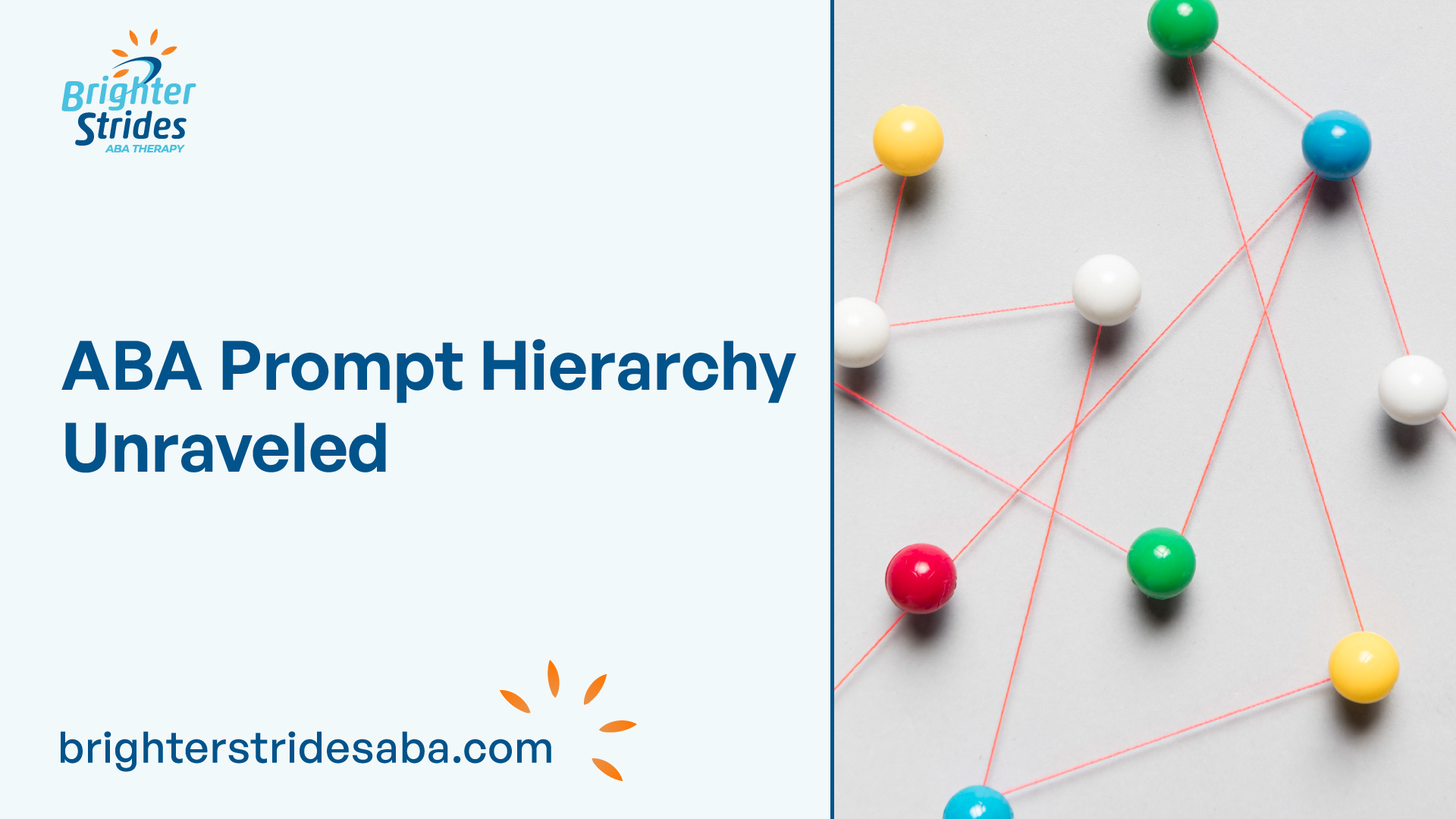Understanding ABA Prompt Hierarchy
When it comes to Applied Behavior Analysis (ABA), prompt hierarchy plays a crucial role in facilitating learning and skill development. Understanding the concept of ABA prompts and the importance of prompt hierarchy is essential for effective implementation of ABA principles.

Definition of ABA Prompts
ABA prompts refer to cues or assistance provided to an individual to help them learn and perform a specific behavior or skill. These prompts serve as guides or reminders to prompt correct responses and guide individuals towards desired outcomes. ABA prompts can take various forms, such as physical prompts, verbal prompts, or model prompts. The goal of using prompts is to provide the necessary support for individuals to acquire and demonstrate new skills.
Importance of Prompt Hierarchy
Prompt hierarchy is a systematic approach that outlines the order and progression of prompts used during teaching or intervention. It establishes a clear structure and framework for gradually fading prompts over time, allowing individuals to become more independent in their behavior and skill performance.
The significance of prompt hierarchy lies in its ability to promote skill acquisition while minimizing prompt dependency. By starting with more intrusive prompts and gradually fading them, individuals are encouraged to rely less on external cues and prompts, and instead, develop independent problem-solving and decision-making skills.
By following a well-structured prompt hierarchy, educators, therapists, and caregivers can effectively scaffold learning and provide appropriate support based on an individual’s current skill level. This helps to ensure that individuals progress through the learning process at a pace that is tailored to their needs, increasing the likelihood of successful skill acquisition and generalization.
Understanding and implementing prompt hierarchy within the framework of ABA is crucial for promoting independence and fostering long-term skill retention. It empowers individuals to apply newly acquired skills in diverse settings and situations, leading to meaningful and lasting behavior change.
Types of ABA Prompts
When implementing Applied Behavior Analysis (ABA) therapy, the use of prompts is a crucial component in helping individuals learn and develop new skills. ABA prompts provide guidance and support to individuals, enabling them to respond correctly to a given instruction or situation. There are different types of ABA prompts that can be utilized based on the individual’s needs and learning style. The three main types of prompts are physical prompts, verbal prompts, and model prompts.
Physical Prompts
Physical prompts involve physical guidance or assistance to help the individual complete a desired behavior or task. These prompts can range from full physical support to partial physical guidance, depending on the individual’s needs and abilities. Physical prompts may include hand-over-hand assistance, gentle touches, or physical cues to guide the individual’s movements.
Physical prompts are particularly useful for individuals who require direct physical assistance to understand and perform a specific behavior. They can be effective in teaching motor skills, such as hand-eye coordination or fine motor movements. However, it is important to fade physical prompts gradually to promote independence and reduce prompt dependency.
Verbal Prompts
Verbal prompts involve the use of spoken or auditory cues to guide the individual’s behavior. These prompts can be as simple as providing a verbal instruction or cue to help the individual initiate or complete a task. Verbal prompts may include direct instructions, hints, or reminders to assist the individual in responding correctly.
Verbal prompts are beneficial for individuals who respond well to auditory cues and have good receptive language skills. They can be used to prompt a specific action, provide guidance, or reinforce correct responses. Verbal prompts offer a more natural and less intrusive form of support compared to physical prompts.
Model Prompts
Model prompts involve demonstrating the desired behavior or task for the individual to imitate or replicate. The therapist or caregiver performs the action or behavior, serving as a model for the individual to follow. Model prompts can be used to teach a wide range of skills, including social interactions, play skills, and daily living activities.
Model prompts provide a visual representation of the desired behavior, making it easier for individuals to understand and imitate. They are particularly effective for individuals who learn best through observation and imitation. Model prompts can be combined with other types of prompts to enhance learning and skill acquisition.
By utilizing a combination of physical prompts, verbal prompts, and model prompts, ABA therapists can tailor their approach to meet the individual’s specific needs and learning style. It is important to select the most appropriate type of prompt based on the individual’s abilities, preferences, and the target skill being taught. The goal is to gradually fade prompts over time, promoting independence and generalization of the learned skills.
Implementing ABA Prompt Hierarchy
When it comes to implementing ABA (Applied Behavior Analysis) prompt hierarchy, two commonly used techniques are prompt fading and errorless teaching. These techniques help individuals with developmental disabilities acquire new skills and promote independence.
Prompt Fading
Prompt fading is a gradual process of reducing or fading prompts over time to promote independent responding. It involves systematically decreasing the level of assistance provided during a task or skill acquisition. The goal of prompt fading is to fade out prompts until the individual can perform the task independently [1].
The process of prompt fading typically involves the following steps:
- Initially, a high level of assistance, such as a physical or verbal prompt, is provided to help the individual complete the task successfully.
- As the individual becomes more proficient, the level of assistance is gradually reduced. For example, a physical prompt may be faded to a gestural prompt, then to a verbal prompt, and eventually to no prompt at all.
- The fading process continues until the individual can perform the task independently without any prompts.
Prompt fading allows individuals to develop their skills gradually and build confidence in their abilities. It promotes the transfer of control from the prompter to the individual, enabling them to become more independent in completing tasks.
Errorless Teaching
Errorless teaching is a teaching method that emphasizes minimizing errors during skill acquisition. It involves providing prompts and cues to ensure that the individual responds correctly, thus preventing errors from occurring [2].
Key principles of errorless teaching include:
- Providing a highly structured and controlled learning environment.
- Using clear and concise instructions to guide the individual’s behavior.
- Presenting prompts or cues immediately to ensure correct responding.
- Gradually reducing the level of prompts as the individual becomes more proficient.
- Offering positive reinforcement for correct responses to reinforce learning.
Errorless teaching is particularly beneficial for individuals who may become frustrated or discouraged by making errors. By minimizing errors, individuals can experience success and build a foundation of correct responses, which can enhance learning and promote skill development [3].
By implementing prompt fading and errorless teaching techniques, ABA practitioners can effectively teach individuals with developmental disabilities new skills while minimizing errors and fostering independence. These techniques, when applied appropriately and systematically, can help individuals acquire and generalize skills across various settings.
Individualizing ABA Prompts
When implementing Applied Behavior Analysis (ABA) therapy, it is crucial to individualize the prompt levels based on the needs and abilities of the learner. By assessing and adjusting the prompt levels, therapists can provide the appropriate level of support to help individuals acquire and generalize new skills.
Assessing Prompt Levels
Assessing prompt levels involves determining the level of assistance needed by the learner to successfully complete a task or behavior. This assessment is typically done through careful observation and analysis of the learner’s performance. The goal is to identify the least intrusive prompt that allows the learner to respond correctly.
There are several methods for assessing prompt levels, including:
- Systematic Prompt Fading: This involves systematically reducing the intensity or intrusiveness of prompts. By gradually fading the prompts, therapists can determine the level at which the learner can perform the behavior independently.
- Least-to-Most Prompting: This approach starts with the least intrusive prompts and gradually increases the level of assistance if needed. It allows therapists to quickly identify the prompt level that leads to successful responses.
- Most-to-Least Prompting: In contrast to the least-to-most prompting, this approach begins with the most intrusive prompts and gradually decreases the level of assistance. It is useful for learners who may require more support initially.
Adjusting Prompt Levels
Once prompt levels have been assessed, it is important to continuously monitor and adjust them based on the learner’s progress. As the learner becomes more proficient in a particular skill, the prompt level should be systematically reduced to promote independence.
On the other hand, if the learner is struggling to acquire a skill or behavior, it may be necessary to increase the prompt level temporarily. This allows the learner to experience success and build confidence before gradually fading the prompts again.
Adjusting prompt levels should be done carefully and systematically. It is essential to strike a balance between providing enough support for success and promoting independence. Regular data collection and behavior analysis can help guide the decision-making process and ensure prompt levels are tailored to the learner’s specific needs.
By individualizing prompt levels, ABA therapists can effectively facilitate skill acquisition and generalization for individuals receiving therapy. The continuous assessment and adjustment of prompts allow learners to progress at their own pace, ultimately leading to greater independence and mastery of targeted skills.
Challenges in ABA Prompting
Implementing ABA prompt hierarchy can come with its own set of challenges. Two common challenges faced are prompt dependency and generalization issues. Understanding and addressing these challenges is crucial for effective ABA implementation.
Prompt Dependency
Prompt dependency refers to a situation where an individual becomes reliant on prompts to complete a task or exhibit a desired behavior. While prompts are initially used to teach new skills and provide assistance, it is important to gradually fade them to promote independent functioning. When prompt dependency occurs, the individual may struggle to perform the target behavior without the presence of prompts.
To address prompt dependency, it is necessary to implement prompt fading strategies. Prompt fading involves systematically reducing the intensity or frequency of prompts over time. This gradual reduction allows the individual to gain independence and develop the necessary skills to perform the behavior without prompts. By fading prompts appropriately, individuals can achieve long-term success in maintaining the target behavior.
Generalization Issues
Generalization is the ability to apply learned skills across different settings, people, and situations. Generalization issues can arise when individuals struggle to demonstrate the target behavior in settings or situations that differ from the training environment. For example, a behavior that has been successfully taught in a therapy room may not be exhibited in a different room or with different people present.
To address generalization issues, it is important to incorporate generalization strategies during the teaching process. These strategies aim to help individuals transfer and apply learned skills to various contexts. Some common generalization strategies include:
- Teaching in multiple settings: By teaching and practicing the target behavior in different settings, individuals are exposed to a variety of environments and learn to generalize the behavior.
- Involving different people: Involving different individuals in the teaching process helps individuals generalize the behavior to other people and promotes flexibility in responding to different social cues.
- Varying materials and stimuli: Introducing variations in materials, objects, and stimuli during the teaching process helps individuals generalize the behavior to different situations and reduces the reliance on specific cues.
By using these generalization strategies, individuals can learn to apply the target behavior in a range of settings and situations, leading to more functional and adaptive behavior.
Understanding and addressing the challenges of prompt dependency and generalization issues is essential for successful implementation of ABA prompt hierarchy. With proper strategies and techniques, individuals can develop independent skills and generalize behaviors to real-world settings, promoting meaningful and lasting behavior change.
Monitoring Progress in ABA Prompting
When implementing Applied Behavior Analysis (ABA) prompt hierarchy, it is crucial to monitor the progress of individuals to ensure effective intervention and learning. Monitoring progress involves collecting data and analyzing behavior to make informed decisions and adjustments. Two key aspects of monitoring progress in ABA prompting are data collection and behavior analysis.
Data Collection
Data collection plays a vital role in monitoring progress in ABA prompting. It involves systematically recording and analyzing information about the individual’s responses, prompts used, and overall progress. By collecting data, practitioners can track changes over time, identify patterns, and make data-driven decisions regarding prompt levels and intervention strategies.
There are various methods for collecting data in ABA prompting, including:
- Direct observation: This involves observing and recording the individual’s behavior in real-time. Observers may use tools such as checklists, rating scales, or event recording to gather data accurately.
- Video recording: Video recording can be a valuable tool in data collection as it allows for detailed analysis and review of the individual’s responses, prompt levels, and progress. It enables practitioners to closely examine specific behaviors and make more accurate assessments.
- Electronic data collection: With advancements in technology, electronic data collection systems have become increasingly popular. These systems allow for efficient data entry, analysis, and reporting, saving time and ensuring accuracy.
By consistently collecting and analyzing data, practitioners can make informed decisions about adjusting prompt levels, modifying teaching strategies, and tracking progress over time.
Behavior Analysis
Behavior analysis is another essential aspect of monitoring progress in ABA prompting. It involves examining the individual’s responses and behaviors in relation to the prompts provided. Behavior analysis helps practitioners gain insights into the effectiveness of the prompts and make informed decisions about adjusting prompt levels or implementing alternative strategies.
By conducting behavior analysis, practitioners can:
- Identify prompt dependency: Behavior analysis helps determine if the individual is becoming overly reliant on prompts or if they are demonstrating increased independence in their responses. This information guides practitioners in fading prompts appropriately and promoting skill generalization.
- Assess skill acquisition: Behavior analysis allows practitioners to assess the individual’s progress in acquiring the targeted skills. It helps identify areas of strength and areas that may require additional support or intervention.
- Measure generalization: Generalization refers to the individual’s ability to apply learned skills across different settings, people, and materials. Behavior analysis helps practitioners assess the extent to which the individual is generalizing skills, allowing for targeted interventions and support.
By combining data collection with behavior analysis, practitioners can gain a comprehensive understanding of the individual’s progress in ABA prompting. This information enables them to make evidence-based decisions, modify intervention strategies, and promote skill development effectively.
References
- https://masteraba.com/prompt-hierarchy/#:~:text=The%20prompt%20hierarchy%20serves%20as,a%20new%20skill%20or%20behavior.
- https://www.sunnydayssunshinecenter.com/blog/prompt-fading-tips#:~:text=Also%20known%20as%20most%2Dto,less%20intrusive%20than%20the%20last.
- https://www.medbridge.com/blog/2016/02/errorless-learning-motivating-strategy-for-patients-with-memory-impairment/

 We've just released an article! Check out our blog!
We've just released an article! Check out our blog! 


